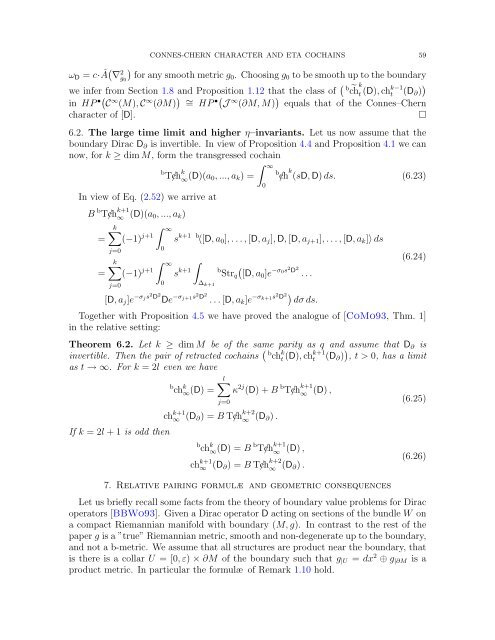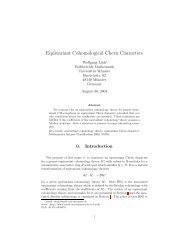Connes-Chern Character for Manifolds with Boundary and ETA ...
Connes-Chern Character for Manifolds with Boundary and ETA ...
Connes-Chern Character for Manifolds with Boundary and ETA ...
You also want an ePaper? Increase the reach of your titles
YUMPU automatically turns print PDFs into web optimized ePapers that Google loves.
CONNES-CHERN CHARACTER AND <strong>ETA</strong> COCHAINS 59<br />
ω D = c·Â( )<br />
∇ 2 g 0 <strong>for</strong> any smooth metric g0 . Choosing g 0 to be smooth up to the boundary<br />
we infer from Section 1.8 <strong>and</strong> Proposition 1.12 that the class of ( k<br />
b ˜ch t (D), ch k−1<br />
t (D ∂ ) )<br />
in HP •( C ∞ (M), C ∞ (∂M) ) ∼ ( = HP<br />
•<br />
J ∞ (∂M, M) ) equals that of the <strong>Connes</strong>–<strong>Chern</strong><br />
character of [D].<br />
□<br />
6.2. The large time limit <strong>and</strong> higher η–invariants. Let us now assume that the<br />
boundary Dirac D ∂ is invertible. In view of Proposition 4.4 <strong>and</strong> Proposition 4.1 we can<br />
now, <strong>for</strong> k ≥ dim M, <strong>for</strong>m the transgressed cochain<br />
b T/ch k ∞ (D)(a 0, ..., a k ) =<br />
In view of Eq. (2.52) we arrive at<br />
∫ ∞<br />
0<br />
b /ch k (sD, D) ds. (6.23)<br />
B b T/ch k+1<br />
∞ (D)(a 0, ..., a k )<br />
k∑<br />
∫ ∞<br />
= (−1) j+1 s k+1 b 〈[D, a 0 ], . . . , [D, a j ], D, [D, a j+1 ], . . . , [D, a k ]〉 ds<br />
j=0<br />
0<br />
k∑<br />
∫ (6.24)<br />
∞<br />
(<br />
= (−1) j+1 s k+1<br />
j=0<br />
0<br />
∫∆ b Str q [D, a0 ]e −σ 0s 2 D 2 . . .<br />
k+1<br />
)<br />
[D, a j ]e −σ js 2 D 2 De −σ j+1s 2 D 2 . . . [D, a k ]e −σ k+1s 2 D 2 dσ ds.<br />
Together <strong>with</strong> Proposition 4.5 we have proved the analogue of [CoMo93, Thm. 1]<br />
in the relative setting:<br />
Theorem 6.2. Let k ≥ dim M be of the same parity as q <strong>and</strong> assume that D ∂ is<br />
invertible. Then the pair of retracted cochains ( b ch k t (D), ch k+1<br />
t (D ∂ ) ) , t > 0, has a limit<br />
as t → ∞. For k = 2l even we have<br />
l∑<br />
b ch k ∞(D) = κ 2j (D) + B b T/ch k+1<br />
∞ (D) ,<br />
(6.25)<br />
j=0<br />
ch k+1<br />
∞ (D ∂ ) = B T/ch k+2<br />
∞ (D ∂) .<br />
If k = 2l + 1 is odd then<br />
b ch k ∞(D) = B b T/ch k+1<br />
∞ (D) ,<br />
ch k+1<br />
∞ (D ∂ ) = B T/ch k+2<br />
∞ (D ∂) .<br />
7. Relative pairing <strong>for</strong>mulæ <strong>and</strong> geometric consequences<br />
(6.26)<br />
Let us briefly recall some facts from the theory of boundary value problems <strong>for</strong> Dirac<br />
operators [BBWo93]. Given a Dirac operator D acting on sections of the bundle W on<br />
a compact Riemannian manifold <strong>with</strong> boundary (M, g). In contrast to the rest of the<br />
paper g is a ”true” Riemannian metric, smooth <strong>and</strong> non-degenerate up to the boundary,<br />
<strong>and</strong> not a b-metric. We assume that all structures are product near the boundary, that<br />
is there is a collar U = [0, ε) × ∂M of the boundary such that g |U = dx 2 ⊕ g |∂M is a<br />
product metric. In particular the <strong>for</strong>mulæ of Remark 1.10 hold.

















